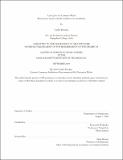Life cycle of a common weed : reciprocity, anxiety and the aesthetics of noncatharsis
Author(s)
Berrigan, Caitlin (Caitlin Elizabeth)
DownloadFull printable version (35.10Mb)
Other Contributors
Massachusetts Institute of Technology. Dept. of Architecture.
Advisor
Krzysztof Wodiczko.
Terms of use
Metadata
Show full item recordAbstract
This document is a condensation of research into an artistic practice of transation and dialogue. Through the staging of an artwork, I offer encounters with fractured biopolitics and forms of social engagement. Written in three parts, this document may be read as separate yet interdependent components of a distributed narrative. The first section begins with a straightforward description and documentation of an artistic concept that evolved during my time at MIT. The artwork, Life Cycle of a Common Weed, is a fertile encounter between plants and humans. The material transfer of nutrients is the critical locus of this exchange: blood from a human body nourishes dandelions with nitrogen and the root and leaves of the dandelion provide nutritious and medicinal sustenance to the human. Liminally present in the exchange are pathogenic viruses and empathy. Life Cycle of a Common Weed is not an object-based artwork, and as such exists as a performance, visual documentation, an event, and a perpetual cultivation. In the second section, I describe the emergence of Life Cycle of a Common Weed from a rhizomatic web of embodied knowledges, multispecies encounters, cultural symbols and practices, dialogues and lateral transfers. I have infected the philosophical abstractions of the artist's statement genre with a situated ethnography that joins the artwork to nodes of questions and contexts, but by no means circumscribes its entire network of connectivity. The final section identifies the work of other artists as important antecedents, as well as audience encounters that provoked reflection on my approach. (cont.) In relation to my other work and the unfolding narrative of its creation, Life Cycle of a Common Weed is situated as a turning point within my artistic practice.
Description
Thesis (S.M. in Visual Studies)--Massachusetts Institute of Technology, Dept. of Architecture, 2009. This electronic version was submitted by the student author. The certified thesis is available in the Institute Archives and Special Collections. Cataloged from student-submitted PDF version of thesis. Includes bibliographical references (p. 95-100).
Date issued
2009Department
Massachusetts Institute of Technology. Department of ArchitecturePublisher
Massachusetts Institute of Technology
Keywords
Architecture.